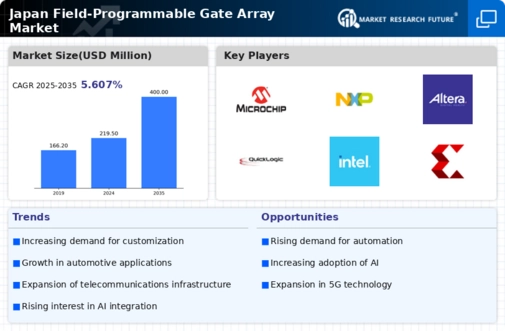Rising Demand for Customizable Solutions
The field programmable-gate-array market in Japan is benefiting from the rising demand for customizable solutions across various industries. As businesses seek to differentiate their products and services, the ability to tailor hardware solutions to specific needs becomes increasingly important. FPGAs offer unparalleled flexibility, allowing companies to modify their designs post-manufacturing, which is particularly advantageous in fast-paced markets. This trend is evident in sectors such as consumer electronics and industrial automation, where customization is key to maintaining a competitive edge. In 2025, the market for customizable FPGA solutions is expected to grow by approximately 12%, reflecting the increasing preference for adaptable technologies. This shift highlights the pivotal role of the field programmable-gate-array market in meeting the evolving demands of diverse industries.
Technological Advancements in Electronics
The field programmable-gate-array market in Japan is experiencing a surge due to rapid technological advancements in electronics. Innovations in semiconductor technology have led to the development of more efficient and powerful FPGAs, which are increasingly utilized in various applications, including telecommunications and automotive sectors. The Japanese electronics industry, known for its cutting-edge technology, is likely to drive demand for FPGAs, as companies seek to enhance product performance and reduce time-to-market. In 2025, the market is projected to grow at a CAGR of approximately 8%, reflecting the increasing reliance on FPGAs for complex electronic designs. This trend indicates a robust future for the field programmable-gate-array market, as manufacturers continue to invest in research and development to create next-generation products.
Growing Adoption in Automotive Applications
The automotive sector in Japan is witnessing a significant transformation, with the integration of advanced technologies such as autonomous driving and electric vehicles. This shift is driving the demand for FPGAs, which offer flexibility and reconfigurability essential for developing complex automotive systems. The field programmable-gate-array market is expected to benefit from this trend, as automotive manufacturers increasingly adopt FPGAs for applications like advanced driver-assistance systems (ADAS) and infotainment systems. In 2025, the automotive segment is anticipated to account for over 25% of the total FPGA market share in Japan, highlighting the critical role of FPGAs in enhancing vehicle performance and safety. This growing adoption underscores the importance of the field programmable-gate-array market in supporting the evolution of the automotive industry.
Expansion of Telecommunications Infrastructure
The expansion of telecommunications infrastructure in Japan is a crucial driver for the field programmable-gate-array market. As the demand for high-speed internet and advanced communication technologies increases, telecommunications companies are investing heavily in upgrading their networks. FPGAs play a vital role in this transformation, providing the necessary processing power and flexibility to support next-generation communication standards such as 5G. In 2025, the telecommunications sector is projected to represent a significant portion of the FPGA market, with an estimated growth rate of 10%. This expansion indicates a strong reliance on FPGAs to enhance network performance and meet the growing consumer demand for faster and more reliable communication services.
Increased Investment in Research and Development
Japan's commitment to innovation is reflected in the increased investment in research and development across various sectors, including the field programmable-gate-array market. Government initiatives and funding programs aimed at fostering technological advancements are likely to stimulate growth in this market. Companies are encouraged to explore new applications for FPGAs, particularly in areas such as telecommunications, healthcare, and industrial automation. The Japanese government has allocated approximately ¥500 billion to support technology-driven projects in 2025, which may lead to breakthroughs in FPGA technology. This focus on R&D is expected to enhance the competitiveness of the field programmable-gate-array market, positioning Japan as a leader in FPGA innovation.























Leave a Comment